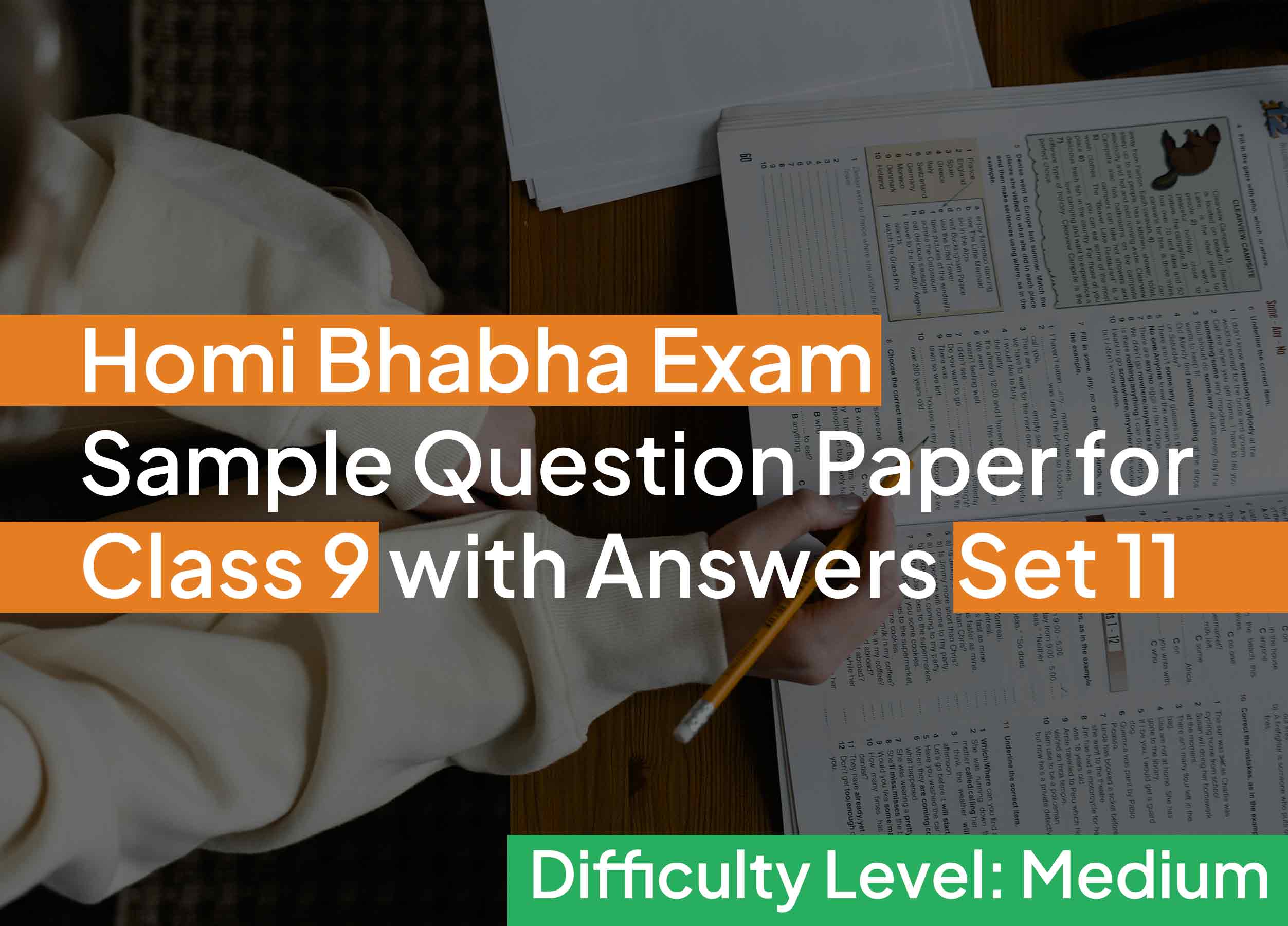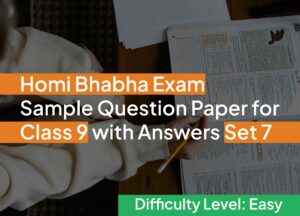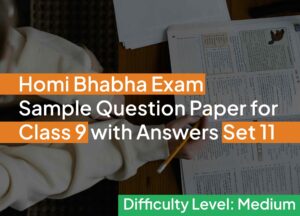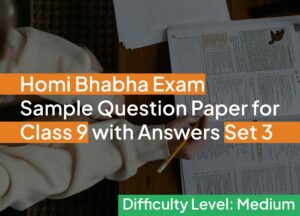Dr. Homi Bhabha Exam sample question paper for Class 9 with our comprehensive set 12 is designed specifically for students following the Maharashtra State Board curriculum, aligning perfectly with the textbooks for 7th, 8th, and 9th standards. This sample question paper is designed to challenge students with in-depth, analytical questions from Maharashtra State Board, CBSE, ICSE, and IB textbooks, covering fundamental science concepts at a high difficulty level.
With questions set at a medium difficulty level, students can effectively enhance their understanding and confidence. Each question aims to challenge students while reinforcing their knowledge, making this resource invaluable preparing for DHBBVS.
1. What is the main function of the xylem in plants?
a) Transport of food
b) Transport of water
c) Photosynthesis
d) Respiration
Answer: b) Transport of water
Explanation: Xylem transports water and minerals from the roots to the rest of the plant.
2. What is the SI unit of force?
a) Newton
b) Pascal
c) Joule
d) Watt
Answer: a) Newton
Explanation: Force is measured in Newtons (N), named after Sir Isaac Newton.
3. Which gas is necessary for photosynthesis?
a) Oxygen
b) Nitrogen
c) Carbon dioxide
d) Hydrogen
Answer: c) Carbon dioxide
Explanation: Plants use carbon dioxide during photosynthesis to produce glucose and oxygen.
4. Which of the following is an example of a reversible change?
a) Burning of paper
b) Rusting of iron
c) Melting of ice
d) Cooking of food
Answer: c) Melting of ice
Explanation: Melting of ice is reversible as water can freeze back into ice.
5. What type of energy is stored in a stretched rubber band?
a) Kinetic energy
b) Potential energy
c) Heat energy
d) Chemical energy
Answer: b) Potential energy
Explanation: A stretched rubber band stores potential energy due to its position.
6. What is the main constituent of biogas?
a) Carbon dioxide
b) Methane
c) Nitrogen
d) Hydrogen
Answer: b) Methane
Explanation: Biogas primarily consists of methane, which is used as a fuel.
7. What is the chemical formula of common salt?
a) KCl
b) NaCl
c) CaCl₂
d) MgCl₂
Answer: b) NaCl
Explanation: Sodium chloride (NaCl) is the chemical formula for common salt.
8. Which part of the human digestive system is primarily responsible for nutrient absorption?
a) Stomach
b) Small intestine
c) Large intestine
d) Esophagus
Answer: b) Small intestine
Explanation: The small intestine absorbs nutrients from digested food.
9. What is the boiling point of water at standard atmospheric pressure?
a) 90°C
b) 100°C
c) 120°C
d) 80°C
Answer: b) 100°C
Explanation: Water boils at 100°C under standard atmospheric pressure.
10. Which of the following is an example of a heterogeneous mixture?
a) Saltwater
b) Air
c) Oil and water
d) Vinegar
Answer: c) Oil and water
Explanation: Oil and water do not mix uniformly, making it a heterogeneous mixture.
11. What is the function of white blood cells in the human body?
a) Transport oxygen
b) Provide immunity
c) Clot blood
d) Digest food
Answer: b) Provide immunity
Explanation: White blood cells protect the body by fighting infections.
12. Which planet is known as the “Red Planet”?
a) Mercury
b) Venus
c) Mars
d) Jupiter
Answer: c) Mars
Explanation: Mars appears red due to iron oxide on its surface.
13. What is the chemical formula for limewater?
a) Ca(OH)₂
b) NaOH
c) KOH
d) Mg(OH)₂
Answer: a) Ca(OH)₂
Explanation: Limewater is a solution of calcium hydroxide (Ca(OH)₂).
14. What is the focal length of a plane mirror?
a) 0
b) Infinite
c) Positive
d) Negative
Answer: b) Infinite
Explanation: A plane mirror has an infinite focal length as its reflective surface is flat.
15. What is the primary structural component of cell walls in plants?
a) Cellulose
b) Proteins
c) Lipids
d) Starch
Answer: a) Cellulose
Explanation: Cellulose provides strength and rigidity to plant cell walls.
**16. The frequency of a wave is inversely proportional to its:
a) Amplitude
b) Velocity
c) Wavelength
d) Period
Answer: c) Wavelength
Explanation: Frequency is inversely proportional to the wavelength in wave mechanics.
17. What is the primary source of energy for life on Earth?
a) Wind
b) Fossil fuels
c) The Sun
d) Geothermal energy
Answer: c) The Sun
Explanation: The Sun is the ultimate source of energy for almost all life forms on Earth.
18. What is the SI unit of electric current?
a) Volt
b) Ampere
c) Coulomb
d) Ohm
Answer: b) Ampere
Explanation: Electric current is measured in amperes (A), which is the flow of electric charge per second.
19. Which subatomic particle is negatively charged?
a) Proton
b) Neutron
c) Electron
d) Positron
Answer: c) Electron
Explanation: Electrons are negatively charged subatomic particles orbiting the nucleus.
20. What happens to the pressure of a gas if its volume is halved at constant temperature?
a) Doubles
b) Halves
c) Remains the same
d) Becomes zero
Answer: a) Doubles
Explanation: According to Boyle’s Law, pressure and volume are inversely proportional at constant temperature.
21. Which organelle is known as the “powerhouse of the cell”?
a) Ribosome
b) Chloroplast
c) Mitochondrion
d) Nucleus
Answer: c) Mitochondrion
Explanation: Mitochondria generate energy in the form of ATP for cellular activities.
22. What is the acceleration due to gravity on Earth?
a) 8.9 m/s²
b) 9.8 m/s²
c) 10.8 m/s²
d) 11.8 m/s²
Answer: b) 9.8 m/s²
Explanation: The standard acceleration due to gravity on Earth is approximately 9.8 m/s².
23. Which of the following is an exothermic reaction?
a) Photosynthesis
b) Melting of ice
c) Combustion of fuel
d) Boiling of water
Answer: c) Combustion of fuel
Explanation: Combustion releases heat and light, making it an exothermic reaction.
24. What is the chemical name of washing soda?
a) Sodium carbonate
b) Sodium bicarbonate
c) Calcium carbonate
d) Potassium carbonate
Answer: a) Sodium carbonate
Explanation: Washing soda is chemically known as sodium carbonate (Na₂CO₃).
25. Which law states that “energy can neither be created nor destroyed”?
a) Newton’s First Law
b) Law of Conservation of Energy
c) Boyle’s Law
d) Charles’ Law
Answer: b) Law of Conservation of Energy
Explanation: This law states that energy can only transform from one form to another.
26. What is the primary function of the human liver?
a) Produce bile
b) Pump blood
c) Filter oxygen
d) Store glycogen
Answer: a) Produce bile
Explanation: The liver produces bile, which aids in the digestion of fats.
27. Which type of bond is present in an oxygen molecule (O₂)?
a) Ionic bond
b) Covalent bond
c) Metallic bond
d) Hydrogen bond
Answer: b) Covalent bond
Explanation: Oxygen atoms share electrons through a covalent double bond in an O₂ molecule.
28. What is the term for the phenomenon of bending of light when it passes through a prism?
a) Reflection
b) Refraction
c) Dispersion
d) Diffraction
Answer: c) Dispersion
Explanation: Dispersion occurs when light splits into its constituent colors while passing through a prism.
29. What is the main cause of tides in the Earth’s oceans?
a) Wind
b) Moon’s gravitational pull
c) Sun’s heat
d) Earth’s rotation
Answer: b) Moon’s gravitational pull
Explanation: Tides are primarily caused by the gravitational interaction between the Earth and the Moon.
30. Which gas is commonly used in fire extinguishers?
a) Oxygen
b) Carbon dioxide
c) Nitrogen
d) Methane
Answer: b) Carbon dioxide
Explanation: Carbon dioxide displaces oxygen and helps to smother the fire.
31. What is the pH of pure water at 25°C?
a) 5
b) 7
c) 9
d) 11
Answer: b) 7
Explanation: Pure water is neutral with a pH of 7 at 25°C.
32. What is the smallest structural and functional unit of life?
a) Tissue
b) Organ
c) Cell
d) Organism
Answer: c) Cell
Explanation: The cell is the basic unit of life in all living organisms.
33. What is the formula for calculating speed?
a) Distance × Time
b) Distance / Time
c) Time × Acceleration
d) Acceleration / Time
Answer: b) Distance / Time
Explanation: Speed is defined as the distance traveled per unit of time.
34. Which vitamin is essential for blood clotting?
a) Vitamin A
b) Vitamin C
c) Vitamin K
d) Vitamin D
Answer: c) Vitamin K
Explanation: Vitamin K helps in the synthesis of proteins required for blood clotting.
35. What is the term for an organism that makes its own food?
a) Heterotroph
b) Autotroph
c) Parasite
d) Saprophyte
Answer: b) Autotroph
Explanation: Autotrophs like plants produce their own food through photosynthesis.
36. Which of the following is an example of a scalar quantity?
a) Force
b) Velocity
c) Energy
d) Acceleration
Answer: c) Energy
Explanation: Energy is a scalar quantity as it has magnitude but no direction.
37. Which element is the most abundant in the Earth’s crust?
a) Iron
b) Oxygen
c) Silicon
d) Aluminum
Answer: b) Oxygen
Explanation: Oxygen makes up about 46% of the Earth’s crust by weight.
38. What is the SI unit of temperature?
a) Celsius
b) Kelvin
c) Fahrenheit
d) Rankine
Answer: b) Kelvin
Explanation: Kelvin is the SI unit of temperature measurement.
39. Which device is used to measure atmospheric pressure?
a) Thermometer
b) Barometer
c) Hygrometer
d) Altimeter
Answer: b) Barometer
Explanation: A barometer measures atmospheric pressure.
40. What is the approximate age of the Earth?
a) 3.5 billion years
b) 4.5 billion years
c) 5.5 billion years
d) 6.5 billion years
Answer: b) 4.5 billion years
Explanation: Scientific evidence suggests that Earth is approximately 4.5 billion years old.
If you find this useful, share it with your friends… so they can join you in preparing for Dr. Homi Bhabha Balvaidnyanik Competition or DHBBVS. Together, you can tackle these questions, discuss the answers, and strengthen your knowledge base.
Start reading, keep preparing and stay focused! Let’s achieve greatness together!




